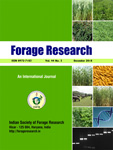GAYATRI KUMARI, SARITA DEVI, CHARAN SINGH, SATPAL*, MONIKA AND PANKAJ
Department of Botany and Plant Physiology, CCSHAU, Hisar-125 004 (Haryana), India
Chaudhary Charan Singh Haryana Agricultural University, Rice Research Station, Kaul,
Kaithal-136 021 (Haryana), India
Forage Section, Department of Genetics and Plant Breeding, CCS HAU, Hisar-125 004 (Haryana), India
*(e-mail: satpal.fpj@gmail.com)
(Received : 14 March 2025; Accepted 30 March 2025)
SUMMARY
Livestock sector directly supports the livelihoods and food security of many people, globally.
A 65% shortage in green fodder and a 25% deficit in dry fodder are predicted to exist by 2025. Sorghum
being a hardy crop can be used for forage purpose. It can tolerate abiotic stress like soil salinity. To
cope up this green and dry fodder deficit, sorghum production for forage purpose from saline soils is
needed. Therefore, the bibliometric analysis evaluated the general state, research trends, updates and
hotspots of fodder sorghum production under saline soils. Scopus database was used to select
journal publications from 2000 to 2023 and the analysis was carried out using VOSviewer and Bibliometrix
software. The results demonstrated that 569 documents (542 original research and 27 reviews) studied
the fodder sorghum production from saline soils over the last 23 years. Increasing number of
publications can be associated with the demand of fodder production from salty areas. Author’s
keywords analysis suggested that the studies focused on sorghum, salt stress, salt tolerance,
physiological changes, gene expression regulation and plant proteins with aim to increase the sorghum
production from saline soils. Asian countries (China and India) are more focused on the alternative for
pasture lands. This in-depth analysis offers future prospects for using sorghum as a fodder crop
grown in saline conditions for sustainable fodder management.
Key words: Fodder sorghum, salinity, salt stress, salt tolerance and bibliometric analysis

